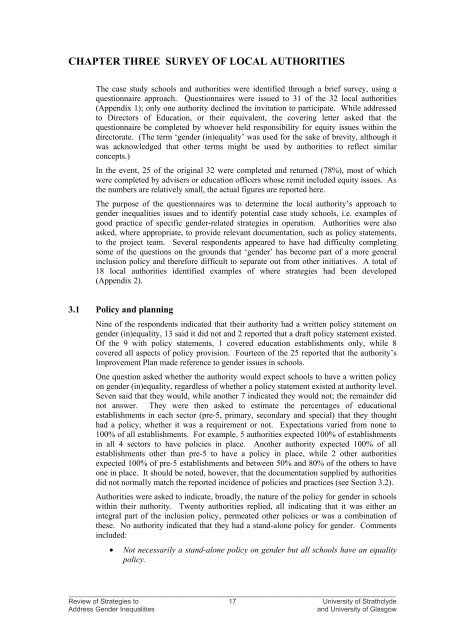Review of Strategies to Address Gender Inequalities in Scottish ...
Review of Strategies to Address Gender Inequalities in Scottish ...
Review of Strategies to Address Gender Inequalities in Scottish ...
You also want an ePaper? Increase the reach of your titles
YUMPU automatically turns print PDFs into web optimized ePapers that Google loves.
CHAPTER THREE SURVEY OF LOCAL AUTHORITIESThe case study schools and authorities were identified through a brief survey, us<strong>in</strong>g aquestionnaire approach. Questionnaires were issued <strong>to</strong> 31 <strong>of</strong> the 32 local authorities(Appendix 1); only one authority decl<strong>in</strong>ed the <strong>in</strong>vitation <strong>to</strong> participate. While addressed<strong>to</strong> Direc<strong>to</strong>rs <strong>of</strong> Education, or their equivalent, the cover<strong>in</strong>g letter asked that thequestionnaire be completed by whoever held responsibility for equity issues with<strong>in</strong> thedirec<strong>to</strong>rate. (The term ‘gender (<strong>in</strong>)equality’ was used for the sake <strong>of</strong> brevity, although itwas acknowledged that other terms might be used by authorities <strong>to</strong> reflect similarconcepts.)In the event, 25 <strong>of</strong> the orig<strong>in</strong>al 32 were completed and returned (78%), most <strong>of</strong> whichwere completed by advisers or education <strong>of</strong>ficers whose remit <strong>in</strong>cluded equity issues. Asthe numbers are relatively small, the actual figures are reported here.The purpose <strong>of</strong> the questionnaires was <strong>to</strong> determ<strong>in</strong>e the local authority’s approach <strong>to</strong>gender <strong>in</strong>equalities issues and <strong>to</strong> identify potential case study schools, i.e. examples <strong>of</strong>good practice <strong>of</strong> specific gender-related strategies <strong>in</strong> operation. Authorities were alsoasked, where appropriate, <strong>to</strong> provide relevant documentation, such as policy statements,<strong>to</strong> the project team. Several respondents appeared <strong>to</strong> have had difficulty complet<strong>in</strong>gsome <strong>of</strong> the questions on the grounds that ‘gender’ has become part <strong>of</strong> a more general<strong>in</strong>clusion policy and therefore difficult <strong>to</strong> separate out from other <strong>in</strong>itiatives. A <strong>to</strong>tal <strong>of</strong>18 local authorities identified examples <strong>of</strong> where strategies had been developed(Appendix 2).3.1 Policy and plann<strong>in</strong>gN<strong>in</strong>e <strong>of</strong> the respondents <strong>in</strong>dicated that their authority had a written policy statement ongender (<strong>in</strong>)equality, 13 said it did not and 2 reported that a draft policy statement existed.Of the 9 with policy statements, 1 covered education establishments only, while 8covered all aspects <strong>of</strong> policy provision. Fourteen <strong>of</strong> the 25 reported that the authority’sImprovement Plan made reference <strong>to</strong> gender issues <strong>in</strong> schools.One question asked whether the authority would expect schools <strong>to</strong> have a written policyon gender (<strong>in</strong>)equality, regardless <strong>of</strong> whether a policy statement existed at authority level.Seven said that they would, while another 7 <strong>in</strong>dicated they would not; the rema<strong>in</strong>der didnot answer. They were then asked <strong>to</strong> estimate the percentages <strong>of</strong> educationalestablishments <strong>in</strong> each sec<strong>to</strong>r (pre-5, primary, secondary and special) that they thoughthad a policy, whether it was a requirement or not. Expectations varied from none <strong>to</strong>100% <strong>of</strong> all establishments. For example, 5 authorities expected 100% <strong>of</strong> establishments<strong>in</strong> all 4 sec<strong>to</strong>rs <strong>to</strong> have policies <strong>in</strong> place. Another authority expected 100% <strong>of</strong> allestablishments other than pre-5 <strong>to</strong> have a policy <strong>in</strong> place, while 2 other authoritiesexpected 100% <strong>of</strong> pre-5 establishments and between 50% and 80% <strong>of</strong> the others <strong>to</strong> haveone <strong>in</strong> place. It should be noted, however, that the documentation supplied by authoritiesdid not normally match the reported <strong>in</strong>cidence <strong>of</strong> policies and practices (see Section 3.2).Authorities were asked <strong>to</strong> <strong>in</strong>dicate, broadly, the nature <strong>of</strong> the policy for gender <strong>in</strong> schoolswith<strong>in</strong> their authority. Twenty authorities replied, all <strong>in</strong>dicat<strong>in</strong>g that it was either an<strong>in</strong>tegral part <strong>of</strong> the <strong>in</strong>clusion policy, permeated other policies or was a comb<strong>in</strong>ation <strong>of</strong>these. No authority <strong>in</strong>dicated that they had a stand-alone policy for gender. Comments<strong>in</strong>cluded:• Not necessarily a stand-alone policy on gender but all schools have an equalitypolicy.______________________________________________________________________________________<strong>Review</strong> <strong>of</strong> <strong>Strategies</strong> <strong>to</strong> 17 University <strong>of</strong> Strathclyde<strong>Address</strong> <strong>Gender</strong> <strong>Inequalities</strong>and University <strong>of</strong> Glasgow
















